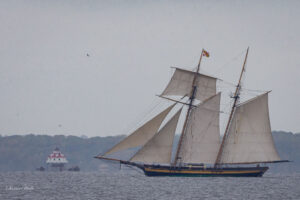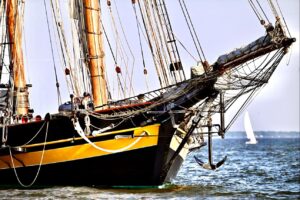
Thunderbolt Bound
Captain’s LogDate: Tuesday, November 12, 2024Time: 1600 ESTPosition: 20 nautical miles east of Point Lookout Lighthouse34°39.7 N x 076°07.25 W Pride has been sailing downwind at speeds between 7-8 knots since

Captain’s LogDate: Tuesday, November 12, 2024Time: 1600 ESTPosition: 20 nautical miles east of Point Lookout Lighthouse34°39.7 N x 076°07.25 W Pride has been sailing downwind at speeds between 7-8 knots since

Captains Log: 9-26-2024 Its always a bit of a bummer to fall asleep to rain, knowing the rain is still going to be there in the morning when you are

Captain’s Log Back in May a large schooner in cargo service was hit by suddenly strong winds during the night and sank not far from the northwest side of

On July 2, 2024, twelve children, 2nd – 5th grade, from Georgetown East Elementary School in Annapolis, accompanied by sixteen parents and mentors, spent an amazing day sailing on Pride

Today’s story is another excerpt from Leslie Bridgett’s Asia with Pride voyage log. Fresh off a plane from Baltimore, Leslie traverses the Panama Canal and prepares to sail over the horizon to Hawaii. Before

Date: Monday, May 6, 2024 Location: Anchored at Annapolis While the 2024 season did not officially start till Maryland Day Celebration weekend of March 23/24, PRIDE’s first underway period started